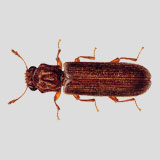Insect-Created “Sawdust” is Called Frass
By Chris Williams on March 4, 2013.
Question
We’ve been rearranging our living room and found a couple of small piles of sawdust in a corner where a large china cabinet used to be. How can we tell what caused the sawdust? I’m worried that the cabinet is infested.
Answer
Probably the first step is to make sure that the sawdust is not just sawdust, left behind by renovation or repairs and maybe shaken loose when the furniture was moved. Entomologists call the “sawdust” created by insects, frass. Depending on the insect, frass contains chewed up wood pieces or fecal pellets that are mostly wood, along with dead insects and miscellaneous debris excavated from the nest site. An expert can usually tell which insect left the frass by looking at it under magnification. The texture is also a clue, whether it feels gritty or smooth to the touch can tell an expert which kind of wood-boring beetle is causing the damage. An expert can sometimes tell whether the frass is fresh or old, an important clue in determining whether you have an active or inactive infestation.

The frass of wood-boring insects is usually hidden away inside their nests or tunnels. It only becomes apparent when it gets pushed out of the tunnels either as a housekeeping measure (carpenter ants do this), when beetles are emerging from the wood through exit holes, or if the wood is disturbed or cut. These are some of the possible insect sources of that sawdust:
Carpenter ants – Carpenter ants don’t eat wood. They shred it with their jaws and dump it out through cracks or slits in the wood. The frass is excavated from the nest through a small slit in the wood and contains small, fibrous slivers of wood, along with debris like bits of insulation or drywall, dead ants and other insects.
 Powderpost beetles – There are three different kinds of powderpost beetles that infest different types of wood in homes. They eat the wood and leave behind tiny, rounded fecal pellets. The frass of the lyctid powderpost beetle is fine and powdery. If you rub it between your fingers, it feels smooth. The frass of anobiid powderpost beetles is powdery but with tiny pellets and feels gritty. The frass of bostrichid powderpost beetles has the consistency of meal and tends to stick together.
Powderpost beetles – There are three different kinds of powderpost beetles that infest different types of wood in homes. They eat the wood and leave behind tiny, rounded fecal pellets. The frass of the lyctid powderpost beetle is fine and powdery. If you rub it between your fingers, it feels smooth. The frass of anobiid powderpost beetles is powdery but with tiny pellets and feels gritty. The frass of bostrichid powderpost beetles has the consistency of meal and tends to stick together.
Other wood-boring beetles – Larger wood-boring beetles invade wood before it is used in construction and can emerge some time later inside homes. Depending on the species, their frass varies from the consistency of cornmeal to the consistency of pipe tobacco. The frass of one beetle, the old house borer, is powdery with barrel-shaped pellets.
The good news is that you can rule out subterranean termites. They don’t leave sawdust-like frass. Their frass is mudlike, with no wood particles visible. Give Colonial a call. Our trained technicians can tell you whether or not that sawdust is cause for concern. If you can’t leave the sawdust undisturbed until then, collect some for our technician to examine.